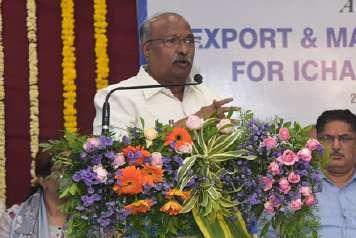
6 minute read
Organic Cotton: A Sustainable Solution for the Fashion Industry - Ms. Somasree Roy
ORGANIC COTTON – A SUSTAINABLE SOLUTION FOR THE FASHION INDUSTRY
MS. SOMASREE ROY
Advertisement
Textile Value Chain
As people become more aware of the environmental impact that synthetic fibres create, sustainable and environment-friendly materials are being developed. The development of these fibres that can substitute synthetic fibres has piqued the curiosity of researchers. As a result of our collective awareness of the fashion industry’s ecological consequences, businesses have begun to embrace sustainable materials.
One of the most dramatic changes has been the shift away from traditional cotton. As an environmentally friendly option, sustainable and socially responsible businesses are now adopting organic cotton fabric as well. The process of production is less damaging to the environment and humans. Unlike the traditional style, which uses synthetic pesticides and hazardous chemicals, organic farming has a lowimpact approach.
What is Organic Cotton?
Organic cotton is a type of cotton that has been grown naturally without using synthetic agricultural agents like fertilisers or pesticides. In addition, the crop is farmed without the use of genetically-engineered organisms. Organic cotton cultivation’s ingredients, agricultural procedures, and manufacturing techniques are environmentally friendly as opposed to traditional cotton growing. It was first cultivated in the 1980s as a means of ensuring sustainable, environmentally friendly, and organic farming. Organic cotton benefits human and environmental health by promoting and enhancing biodiversity, soil biological activity, and biological cycles. Organic cotton is the most skin-friendly, relaxing, and safe natural fabric.
Application
• Organic cotton, unlike ordinary cotton, is never sensitive to infant skin. It’s the perfect material for covering and cleaning newborns, especially for producing garments, bandages, cleaning and disinfecting injuries, baby crib bedding, baby outfits, towels, and a variety of other items. • It is used in making clothes. Bedding, T-shirts, underwear, and even footwear are all made using it. Ear swabs, cotton pads, and sanitary napkins are among the personal care products that contain this substance. • It can also be used effectively in procedures where infection from any cause is potentially lethal. • Organic Cotton Seed Oil, a residue of organic cotton production, is widely used in snacks and livestock feed.
Market Demand
Consumers are searching for apparel
Key Points that can exhibit more sustainable manufacturing • Organic cotton 1st cultivated in the 1980’s practises. According to the • The process of production is less damaging to the environ- Textile Exchange’s Cotton ment and humans Demand Insights Report, • Organic cotton is a type of cotton that has been grown naturally without using synthetic agricultural agents demand for organic cotton would climb by 84 percent by 2030, relative to a base• Organic cotton is the most skin-friendly, relaxing, and secure line year of 2019/20. This natural fabric. shift to organic cotton is a • Tanzania (5%), Tajikistan (4%), and the United States were the top organic cotton-producing countries positive step forward for the fashion industry. • Uzbekistan and Myanmar were added to the list of organic cotton growers in 2019–20. Tanzania (5%), Tajikistan (4%), and the United States were the top seven organic cotton-producing countries in terms of output, accounting for 95% of global output (3%). In 2019–20, two new nations — Uzbekistan and Myanmar — were added to the list of organic cotton growers, with at least three more likely in the coming years. Tanzania and Kyrgyzstan were the two countries that contributed the most to global growth in 2019–20, followed by Uganda, the US, Pakistan, India, and Turkey.
The Benefits of Organic Cotton Ecofriendly 1. Eco-friendly
It is the outcome of a technique of agriculture that is both ecologically friendly and efficient. Organic cotton production emits less carbon since it consumes less fuel and energy. It also minimises contamination of water since it is produced without using chemicals. The workers’ health is also not affected. Finally, the production of organic cotton doesn’t include the excess usage of pesticides and fertilizers, which damage the environment irreversibly.
Organic farmers always cultivate other crops along with their cotton to achieve a steady system on their farms that further helps in keeping the soil healthy, supporting wildlife, and conserving topsoil. Cotton farmers may use these crops to create a more secure, convenient, sufficient, and varied food supply as well as an additional means of revenue for their families and communities.
3. Less Water Consumption
When compared to traditional cotton, the method of cultivating and growing organic cotton uses less water. It also minimises nutrient loss and soil degradation, both of which contribute to water contamination. Furthermore, the organic system relies heavily on rainwater for the growth of the crop.
4. High Ethical Standards
Organic clothing is safer since it is made according to more stringent production standards. It is done not just to reduce adverse environmental impacts, but also to ensure customer satisfaction by adhering to high ethical values like Fairtrade Cotton, the Better Cotton Initiative, FLO International, and other global movements that support organic cotton.
5. Ideal for people with Allergies and skin problems.
Organic cotton fabric contains no chemical residues, so anyone with allergies or particular chemical sensitivities will benefit substantially from wearing organic cotton clothes. It feels great on the skin if you don’t have an allergy or chemical sensitivity.Furthermore, most people who swear by organic cotton clothing claim that it smells good compared to conventional cotton.
6. Extremely adaptable
You’ll be happy to know that organic cotton textiles are a very natural fibre that requires minimal care and is highly adaptable when used in making clothes. The durability of the cotton fabric and threads is what makes them excellent for all forms of apparel, so you may use organic cotton for practically any form of clothing. Organic cotton is an excellent choice for designing summer outfits, t-shirts, and blouses.
Drawbacks of Organic cotton
• It’s possible that the yields will be lower than with regular cotton. Lower yields can have a variety of economic and sustainability-related implications and adverse reactions. • In other cases, organic cotton may necessitate extra human labour.
• Converting to organic certification can be a lengthy process (specifically for farm conversions). • Just a small proportion of all cotton farmed is organic (because the demand for organic cotton is also lower). • Organic cotton clothes that are purchased in stores may be more costly than non-certified or normal cotton clothes.
• Growing, producing, supplying, and selling certified organic cotton may pose some business risks for farmers, manufacturers, and sellers. Eco-friendly Techniques Used in Organic Cotton • Synthetic fertilisers, insecticides, herbicides, growth regulators, and seeds with biotech characteristics are forbidden and not used in the growing or harvesting of organic cotton. Because organic cotton growers are not allowed to use the same techniques as traditional farmers, organic cotton requires more effort. • Every crop cultivation, including cotton cultivation, necessitates fertile soil with organic carbon. Crop rotations with legumes, cover crops to preserve soil during harvesting one crop and growing the next, composting green plant material to produce organic fertiliser, and mulching are all methods used in organic systems in order to improve soil fertility. Fertilizer derived from natural sources may be used to boost fertility, while synthetic fertilisers must be avoided. • Organic cotton cultivation is a farming strategy that promotes the growth of biodiversity in order to meet the requirements of the crops. The use of locally adapted pest-tolerant varieties, legume-based crop diversification, crop rotations, and intercropping to preserve soil health, organic sources of fertiliser, and pest control based on prevention by the use of natural enemies and trap crops are all foundations of organic cotton production.
The Future of Organic Cotton
Concerns about living a life free of incredibly hazardous chemicals, the need for an environmentally friendly agricultural and industrial culture, and a growing consciousness about the depletion of natural resources and their repercussions are all factors that are influencing people’s lifestyles around the globe. The significance of organic cotton is highlighted in this perspective. Despite these obstacles, rising concerns and laws about ecological sustainability and safety will boost the market for organic cotton. Customers are also getting more prepared to pay for organic items as they seek out more sustainable practices. As demand and prices for cotton are once again increasing, the future market for organic cotton looks bright.
References:
• https://www.soilassociation.org/take-action/ organic-living/fashion-textiles/organic-cotton/
• https://www.sustainme.in/blogs/news/8-benefits-of-organic-cotton-clothing
• https://indiantextilejournal.com/articles/fadetails.asp?id=644
• https://bettermeetsreality.com/pros-cons-advantages-disadvantages-of-organic-cotton/










